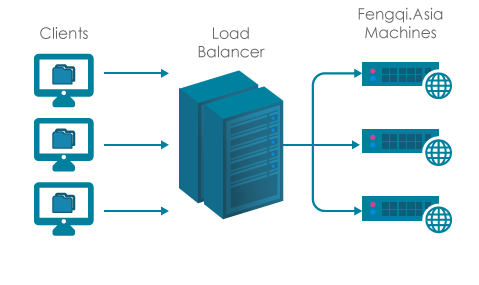
Load Balancer automatically distributes incoming application traffic across your selected Fengqi.Asia machines. It enables you to achieve greater levels of fault tolerance in your application.
This means that the processing load can be shared across many nodes, rather than being limited to a single server, and increasing performance during times of high activity. It also increases the reliability of your web application and allows you to build your application with redundancy. If one of your server nodes fails, the traffic is distributed to your other nodes without any interruption of service.
Why Use Load Balancer
Load balancer is a solution for more than one problem. You can use load balancing to keep your site up through traffic spikes, or grow with your site as it gains popularity. The two most common uses for Load Balancer:
Limiting your points of failure
By limiting your available points of failure, you increase your uptime. If you load balance between two or more identical nodes, in the event that one of the nodes in your cluster experiences any kind of hardware or software failure, the traffic can be automatically redistributed to the other node keeping your site up.
Growing beyond a single server configuration
As your site gains popularity, it will outgrow the power of even the most robust servers, and require something stronger than a single server configuration. The easy step to take is to combine the power of multiple servers with Load Balancing.
Benefits
Achieve higher levels of fault tolerance for your applications by using Load Balancers to automatically route traffic across multiple instances. The Load Balancers ensure that only healthy instances receive traffic by detecting unhealthy instances and rerouting traffic across the remaining healthy instances.
Automatically scales its request handling capacity to meet the demands of application traffic. Additionally, its integration with Flexible Scaling ensures that you have back-end capacity to meet varying levels of traffic levels with minimal effort.
Provides robust networking and security features. You can implement a multi-tiered architecture using internal and internet-facing load balancers to route traffic between application tiers. With this multi-tier architecture, your application infrastructure can use private IP addresses and security groups, allowing you to expose only the internet-facing tier with public IP addresses.
A load balancer helps you optimize how traffic is distributed to the server cluster to ensure the best performance possible. It can also speed up an application, by taking over time-consuming operations such as SSL encryption and decryption.
Features
Reduces the load on application servers and speeds up response times
Add real intelligence to your traffic management rules and get granular control
Scale your Traffic management solution to meet any requirement more efficiently
Reduces that amount of traffic for HTTP objects by compressing files before they are sent.
For end to end security and to speed up SSL encryption and decryption